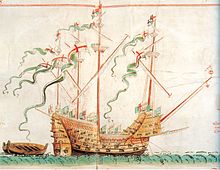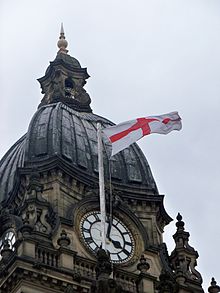Flag of England
The association of the red cross as an emblem of England can be traced back to the Late Middle Ages when it was gradually, increasingly, used alongside the Royal Banner.[citation needed] There then follows a historiographical tradition claiming that Richard the Lionheart himself adopted the full red cross flag and the patron saint from the Republic of Genoa at some point during his crusade.The relevant passage read: The St. George's flag, a red cross on a white field, was adopted by England and the City of London in 1190 for their ships entering the Mediterranean to benefit from the protection of the Genoese fleet.Just as with the Marian persecutions (four years of counter-revolution after his natural death) all defecting clerics faced likely deprivation which was the loss of their office and if more broadly heretical, burning at the stake.[8] Henry V, the history play by William Shakespeare, believed to have been written near 1599 includes the fictitious scene of the battle of Agincourt where the king's final rally is: Cry 'God for Harry!The national flag of England is the Cross of St. George; and that, oddly enough, was splashed from one end of Dublin to the other; it was mostly displayed on shield-shaped banners, and may have been regarded by many as merely religious.In Scotland, and in particular on Scottish vessels at sea, historical evidence suggests that a separate design of Union Flag was flown to that used in England.A desirable variant (per an order from the Earl Marshal in 1938) is for the church to fly the flag with the arms of the diocese in the left-hand upper corner.The flag of England does not figure in legislation, and its use by English nationalists is complex as these divide among those who are far-right as heavily opposed to further immigration and seeking to distinguish between residents in the jobs market and welfare state system such as the British National Party (founded 1982) and the English Defence League (founded 2009) and those who merely seek the level of devolution of Scotland, or Wales.[33][34] This was following a proposal from Jeremy Burge of Emojipedia and Owen Williams of BBC Wales in March 2016,[35][36] The flag is implemented using the regional indicator symbol sequence GB-ENG.










Flag of the United KingdomNational flagSouthseaPortsmouthEnglandconstituent country of the United KingdomSaint George's CrossblazonLate Middle AgesEnglish Reformationmaritime flagwhite ensignUnion JackFlag of GenoaSaint GeorgeWilton Diptychslaying the dragonSt George's CrossPaolo UccelloWat TylerFroissart's ChroniclesBL RoyalcarrackHenry Grace à DieuAnthony RollstreamersHenry II of EnglandPhilip II of Francea crusadeRichard the LionheartRepublic of GenoaVictorian eraPrince Edward, Duke of KentGenoa Expo '92Doge of GenoaEdward IBattle of EveshamBattle of LewesSaint Edward the ConfessorSaint Edmund the Martyrroyal bannerCrusadesEdward IIIBattle of CrécyOrder of the GarterRoyal StandardBook of All Kingdomsfive-crossTbilisiRichard IIEdward the ConfessorEdmund the MartyrVirgin and ChildSaint George's DayEdmundJohn CabotHenry VIINewfoundlandEnglish Protestant Reformationthe teenage kingrevised prayer book of 1552Marian persecutionsHenry Vhistory playWilliam Shakespearebattle of AgincourtUnion of the CrownsSt Andrew's CrossJames VI & IBritainUnion FlagIrish irredentismG. K. ChestertonFlag of the Kingdom of Great Britainof ScotlandActs of Union of 1707Kingdom of ScotlandKingdom of EnglandKingdom of Great BritainKingdom of IrelandSt Patrick's CrossUnited Kingdom of Great Britain and Irelandpartition of IrelandIrish Free StateScotlandCross of Saint PatrickGreat BritainFlag of the City of LondoncantonSaint Paulpatron saintdefacedRoyal NavyCommonwealth of NationsUniversity of BristolUniversity of East AngliaUniversity of HullUniversity of LondonLeeds Town HallChurch of EnglandEarl MarshaldioceseDiocese of Bath and WellsDiocese of BirminghamDiocese of BlackburnDiocese of BristolDiocese of CanterburyDiocese of CarlisleDiocese of ChelmsfordDiocese of ChesterDiocese of DerbyDiocese of ElyDiocese of ExeterDiocese of Gibraltar in EuropeDiocese of GloucesterDiocese of GuildfordDiocese of HerefordDiocese of LeedsDiocese of LeicesterDiocese of LichfieldDiocese of LincolnDiocese of LondonDiocese of ManchesterDiocese of NewcastleDiocese of NorwichDiocese of Oxford

